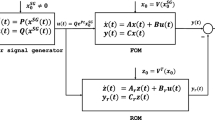Abstract
A new theory on the construction of optimal truncated Low-Dimensional Dynamical Systems (LDDSs) with different physical meanings has been developed. The physical properties of the optimal bases are reflected in the user-defined optimal conditions. Through the analysis of linear and nonlinear examples, it is shown that the LDDSs constructed by using the Proper Orthogonal Decomposition (POD) method are not the optimum. After comparing the errors of LDDSs based on the new theory, POD and Fourier methods, it is concluded that the LDDSs based on the new theory are optimally truncated and catch the desired physical properties of the systems.
Similar content being viewed by others
References
Lumley JL. Whither Turbulence? Turbulence at the Crossroads. New York: Springer-Verlag, 1989
Aubry N, Holmes P, Lumley JL, et al. The dynamics of coherent structures in the wall region of a turbulent boundary layer.J Fluid Mech, 1988, 192:115–173
Deane AE, Keverekidis IG, Karniadakis GE, et al. Low dimensional models for complex geometry flow: application to grooved channels and circular cylinder.Phys Fluids, 1991, A3:2337–2354
Rajaee M, Karlson SKF, Sirovich L. Low-dimensional description of free-shear-flow coherent structures and their dynamical behaviour.J Fouid Mech, 1994, 258:1–29
Lumley JL. The structure of inhomogeneous turbulent flows. In: Yaglom M, Tatarshi VI, eds. Atmospheric Turbulence and Radio Wave Propagation. Moscow: Nauka, 1967. 166–178
Berkooz G, Holmes P, Lumley JL. The proper orthogonal decomposition in the analysis of turbulent flows.Annu Rev Fluid Mech, 1993, 25:539–575
Wu CJ, Shi HS. Advances in flow databases analysis and constructing of low-dimensional dynamical systems.J Hydro, 1994, A9(6):716–723
Wu CJ. Nonlnear Galerkin optimal truncated low-dimensional dynamical system.Comm Nonl Sci & Num Sim, 1996, 1(1):36–42
Fiaccio AV, McCormick CP. Nonlinear Programming—Sequential Unconstrained, Minimization Technique., New York: Jone Wiley & Sons, 1968
Ye QK, Wang ZM. Numerical Methods in Optimizaton and Optimal Control. Beijing: Science Press, 1986 (in Chinese)
Wu CJ, Shi HS. An optimal theory for an expansion of flow quantities, to capture the flow structures.Fluid Dyn Res, 1995, 17:1–19
Whitham GB. Linear and Nonlinear Waves. New York: Jone Wiley & Sons, 1974
Sirovich L. Turbulence and the dynamics of coherent structures, Part I: Coherent structures.Q Appl Math, 1987, 45:561–571
Author information
Authors and Affiliations
Additional information
The project supported by the National Natural Science Foundation of China and LNM, Institute of Mechanics, CAS
Rights and permissions
About this article
Cite this article
Chuijie, W., Hansheng, S. The optimal truncated low-dimensional dynamical systems based on flow databases. Acta Mech Sinica 12, 104–116 (1996). https://doi.org/10.1007/BF02486789
Received:
Revised:
Issue Date:
DOI: https://doi.org/10.1007/BF02486789




